
If you're looking for a place to call home, you need look no further. Affordable housing, top-notch schools, state-of the-art medical facilities, recreation activities, sports adventures, adult community housing, high-wage/high-tech jobs and much, much more are within your reach.
The Andalusia area is growing by leaps and bounds, but her glorious history is well preserved. Click on the link below...look us over; see what you've been missing!
http://www.andalusiachamber.com/
Location:
700 River Falls Street
Andalusia, Alabama 36420
Phone: (334) 222-2030
Fax: (334) 222-7844
Chrissie Duffy, Executive Director
Andalusia Health, a 2005, 2007 and 2011 recipient of Thomson-Reuters Top 100 Hospital designation, is an 88 -bed acute care facility that has served the heart of South Alabama since 1966. Andalusia Health is also accredited by the Joint Commission, and offers a wide range of diagnostic, therapeutic, emergency and surgical services.
Comprehensive Cancer Care is available on Andalusia Health's Campus with services provided by 21st Century Oncology offering Radiation Oncology and Sacred Heart Oncology offering Chemotherapy and infusion services.
Andalusia Health is:
• Rated "A" for Hospital Safety by The Leapfrog Group
• Chest Pain Accredited by the American College of Cardiology
• Recognized as a Baby-Friendly Hospital by Baby-Friendly USA
• Heart Failure Accredited by the American College of Cardiology.
Learn more about Andalusia Health by visiting their website:
Chamber of Commerce
Welcome to Andalusia, The heart of South Alabama.
If you're looking for a place to call home, you need to look no further. Affordable housing, top-notch schools, state-of-the-art medical facilities, recreation activities, sports adventures, adult community housing, high-wage/high-tech jobs and much, much more are within your reach.
The Chamber's home was was the corporate headquarters of Ala-Tex, which at its height manufactured one million dress shirts per year. The grounds are marked with tributes to the leaders of that industry, including Andalusia's "Big Shirt," and a series of mural panels which depict all of the processes of making those dress shirts, beginning with growing and harvesting cotton. At one time, each of the steps was done in Covington County.
Location:
700 River Falls Street
Andalusia, Alabama 36420
Phone: (334) 222-2030
| Andalusia Chamber |
Church Street Cultural Arts Centre
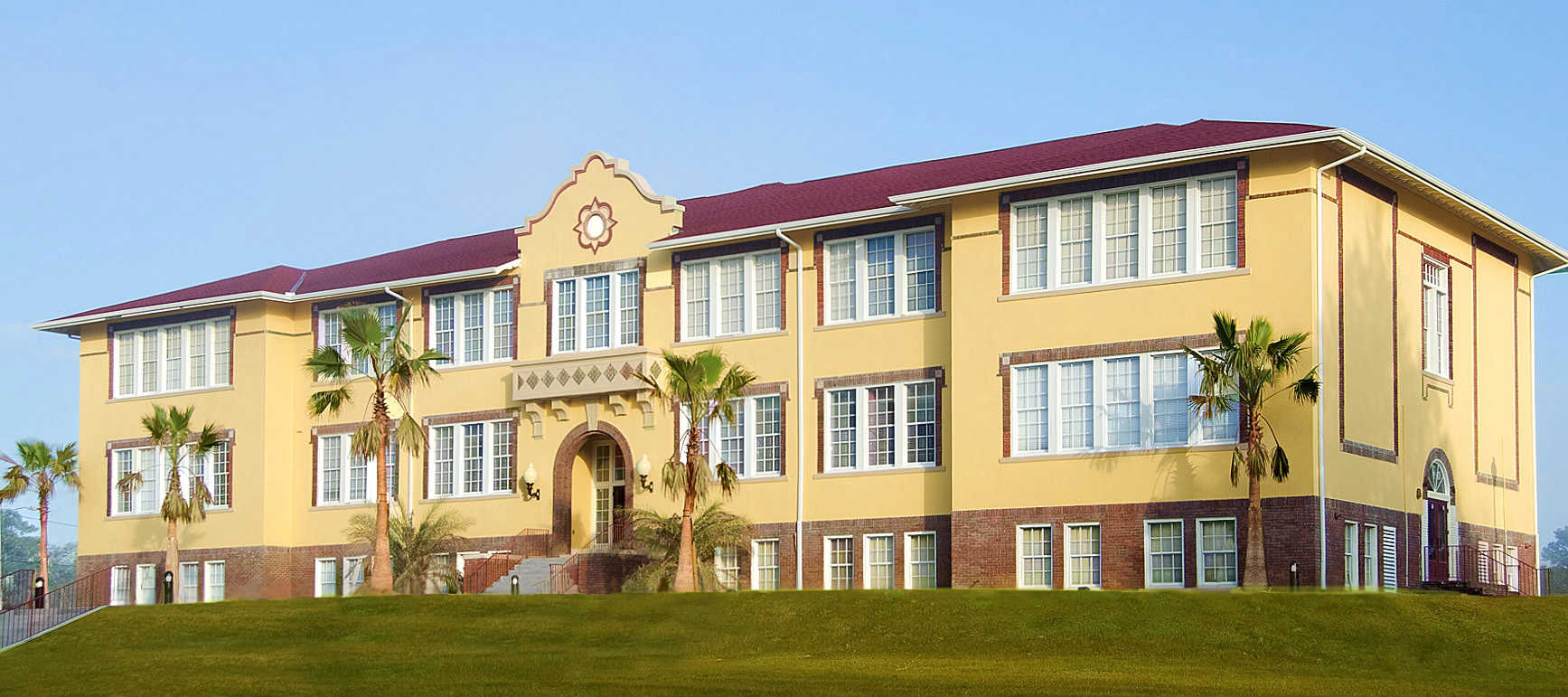
The Church Street Cultural Arts Centre was constructed from 1921 - 1923 serving as a school for the City of Andalusia until December 2000. In 2010 and 2011, the building underwent a renovation that was a joint partnership with the Andalusia Ballet Association and the City. Today, the Church Street Cultural Arts Centre houses the Andalusia Ballet Association and serves as an educational dance facility. The Church Street Cultural Arts Centre also provides space for music lessons and community theatre rehearsals.
Location:
420 Church Street
Andalusia, Alabama 36420
Phone: (334) 222-6891
City Hall
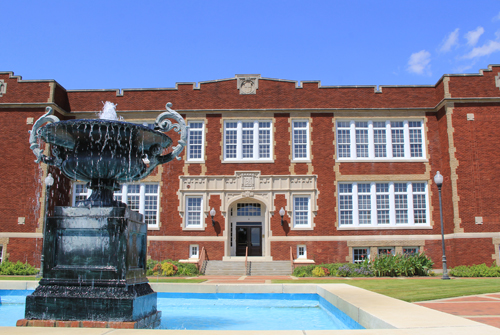 The Andalusia City Hall building was constructed in 1914, serving as a school for the City for eighty-seven years. In 2002 and 2003, the building underwent a complete restoration. The project included removing walls and redesigning the structure for use as a modern city hall. The building was formally dedicated in January 2004 as the Andalusia City Hall. Today, the Andalusia City Hall houses city government and offices for its public utilities. The auditorium once used for school plays and graduations was preserved in the restoration and is used for meetings and special events. Our City Hall serves as a beacon to those interested in doing business in Andalusia. It is the cornerstone of an era of restoration and progress in Andalusia and Covington County.
The Andalusia City Hall building was constructed in 1914, serving as a school for the City for eighty-seven years. In 2002 and 2003, the building underwent a complete restoration. The project included removing walls and redesigning the structure for use as a modern city hall. The building was formally dedicated in January 2004 as the Andalusia City Hall. Today, the Andalusia City Hall houses city government and offices for its public utilities. The auditorium once used for school plays and graduations was preserved in the restoration and is used for meetings and special events. Our City Hall serves as a beacon to those interested in doing business in Andalusia. It is the cornerstone of an era of restoration and progress in Andalusia and Covington County.
Location:
505 East Three Notch Street
Andalusia, Alabama 36420
Phone: (334) 222-3312
Fax: (334) 222-5114
Three Notch Museum

The Three Notch Museum opened to the public in 1987. A project of the Covington Historical Society, the museum has a wonderful collection of articles that relate to Covington County and Andalusia history. An extensive collection of early photographs is one of its featured items. The Mark Gibson miniature Railroad is the place all the children like to visit. The museum also has the River Falls Post Office and the Clark Family Log Cabin. The Country Store takes one back to the days when "mom and pop" type stores dotted our rural countryside.
The museum is open half days on Mondays, Tuesdays and Wednesdays, and by appointment. Admission is free to all visitors and should you want to make a voluntary contribution, there is a contribution jar for your use. Located at the intersection of Historical Central Street and Tisdale Street. Turn south on Central Street from East Three Notch Street.
Location:
Historic Central Street
Andalusia, Alabama 36420
Phone: (334) 222-0674
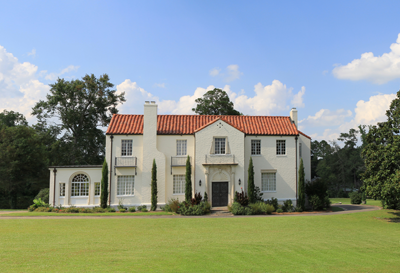 Springdale
Springdale
Springdale, situated in the heart of Andalusia, on East Three Notch Street, is a large home on approximately four acres that was constructed by John G. Scherf in the early 1930s. Scherf was a German immigrant who came to Andalusia to manage the Chamber of Commerce. He later founded the Alabama Textile Products Corp. and also served four terms as mayor, and made major contributions to the city’s economic growth. The estate includes the six-bedroom main house, a meat cellar, a large four-car garage, a guesthouse, a small lake, several fountains, and beautifully landscaped lawns. The City of Andalusia acquired the property in 2010, just before it was scheduled to be autioned, and uses it as a park area. It is available for rent for special events.
| Learn more about Springdale |
Location:
521 E Three Notch Street
Andalusia, AL 36420
Phone: (334) 208-7528
Veterans Memorial
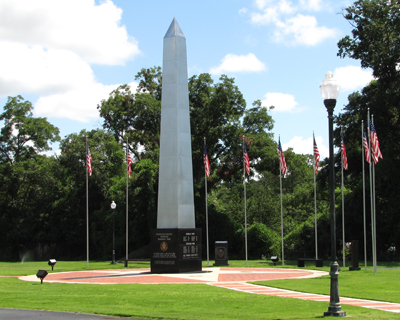
“To those who died, honor and eternal rest; to those who returned, gratitude and peace; to those in service remember and hope”
The Covington County Veterans’ Memorial Park is the product of two years of work by the Covington County Veterans’ Memorial Committee. It was dedicated on Veterans Day in November of 2004. The park and monument were funded entirely through contributions and the sale of bricks and cornerstones. The sale of bricks and cornerstones is an ongoing project.
The Covington County Veterans’ Memorial Park located behind City Hall features a 42-foot tall stainless steel obelisk mounted on a black granite pedestal. The pedestal is engraved with the names of soldiers who lost their lives defending the nation in various wars and conflicts. Brick pavers honoring veterans with ties to Covington County surround the obelisk. A five-pointed star representing the five branches of military service surrounds the brick pavers.
If you are interested in purchasing a brick paver or cornerstone, you may click your choice to download the printable form or please call (334) 222-3312.
Location:
505 East Three Notch Street
Andalusia, Alabama 36420
Phone: (334) 222-3312
Fax: (334) 222-5114
Historic Andalusia Murals
These beautiful historic pieces of art help tell of the history of Andalusia and are located on buildings throughout the downtown area. These murals were created by artist, Wes Hardin. Currently, there are four murals in the collection. They consist of The Legend of Andalusia, Early Covington County Courthouses, Soda Fountain, and Early Covington County Timber and Logging.
A new mural was recently approved by the Andalusia City Council; this mural will also be painted by Dothan artist, Wes Hardin. It will be the first of two murals planned for the Pirate Graphics building on East Three Notch Street.
| Learn more about Andalusia Murals |

The beautiful city of Andalusia located in the “heart of South Alabama,” has a fascinating history which begins on the banks of the Conecuh River at the trading post community called Montezuma. Even though this early settlement below the falls was called Covington Courthouse, the first county seat shown on old maps (1826), by 1829, the name of the post office and the village had changed to Montezuma. To this day, it is uncertain how Montezuma got its name. Historians say that it could have been the Spanish influence of the traders up and down the river to Pensacola or possible refugees moving in from the Mexican Revolution which had just ended.
In 1817, the Alabama territory was formed. The State of Alabama was admitted to the Union in 1819 and Covington County was made a county by the newly formed legislature in 1821. It was named in honor of Brigadier General Leonard Covington, a native of Maryland and hero killed in the War of 1812. Covington County was created from Henry County and through the years has been reduced to its present size by the carving out of Dale and Geneva Counties.
After the Creek Indian War of 1812, legend has it that Andrew Jackson traveled through this area marching troops en route to New Orleans, initially marking a “Three-Notch Trail” through this wilderness, enabling him and his troops to find their way back. It is believed that he or some of his troops camped just north of the present Andalusia city limits near the Heath Community at Soldier’s Head Creek. Other trails were blazed and marked in 1824 through primeval forests from Pensacola to Ft. Gaines, Georgia intersecting the Federal Road begun in 1806 by the federal government to establish a military and postal road from Washington to New Orleans, as well as a trading route to the Indians and a route for settlers moving in from Georgia and the eastern states into the interior of Alabama to build homes and begin farming. From Ft. Crawford near Brewton, the Three-Notch Trail continued along the high ridge line between the Conecuh, the Yellow, and the Pea River watersheds. Since the Three-Notch passed through the area of Andalusia and Troy, streets in both of these towns have been named “Three-Notch” to commemorate the road.
Eventually, a path was worn and wagon ruts appeared, as settlers soon moved into the new state and into Covington County, settling first around Green Bay (1816) and Rose Hill (1823). An early settler named John Devereaux became the first postmaster of Montezuma in 1826 and received a lifelong appointment as a county court judge. His service and contributions are well-documented, and he is commemorated by the naming of the hill where he resided, “Devereaux” or “Debro Hill” as we know it today. As the county’s first senator, he sponsored the enabling acts that created the county, thus he is considered by historians to have earned the title of “Father of Covington County.” Due to political and personal circumstances, Devereaux later moved north to the Union Springs area for a few years and eventually moved westward to East Texas.
In 1841, a catastophic flood in the lowlands around Montezuma that became known as the “Harrison Freshet” brought mosquito fever and devastation to the buildings and homes, forcing settlers to flee to higher ground to a new site. Legislation had already been introduced in 1839 to move the county seat since it is believed that the Montezuma courthouse had burned that year. Records indicate that the post office located inside the courthouse had closed due to fire and was moved to a citizen’s house for a period of time. The little village slowly relocated four miles east of the original site on the highest point up the hill between the Conecuh and Yellow Rivers, a place of safety on the watershed. The new county seat had changed to Andalusia by July 18, 1844, when the post office was established. Following the Spanish theme, Andalusia was laid out, surveyed, and designed in a square around a plaza, the present court square. There are some who speculate that the leaders in the various beats who vigorously favored moving the town up the hill selected the name since legislation had been introduced in 1839 to move the county seat.
Andalusia was formally incorporated on January 9, 1884, after a vote of the local citizenry.
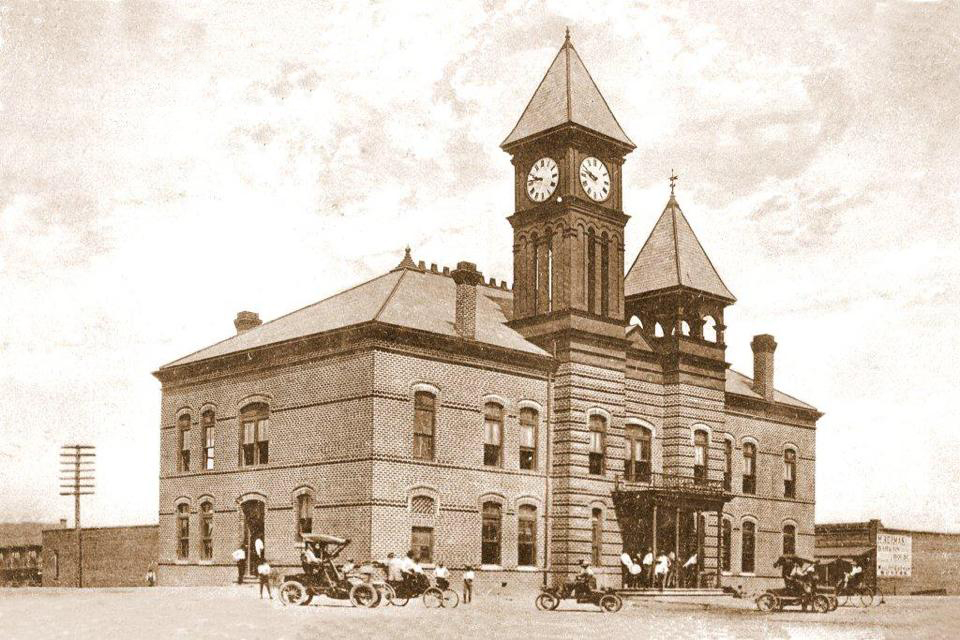 The first courthouse in Andalusia was a two-story square wooden structure built in the center of town between 1844 and 1845 to replace the one at Montezuma. It was consumed by fire on January 13, 1878, destroying all the records.
The first courthouse in Andalusia was a two-story square wooden structure built in the center of town between 1844 and 1845 to replace the one at Montezuma. It was consumed by fire on January 13, 1878, destroying all the records.
The second courthouse in Andalusia was a two-story frame one with four limestone chimneys, two on each side. It burned in October of 1895 after an unsuccessful arson attempt in August of that same year. Probate Judge Malachi Riley saved some of the records which were stored in his safe.
The third courthouse was a two-story brick one with a clock tower built in the center of the town square in 1897 that served the county for about twenty years.
In 1916, the present courthouse, a much larger facility, was built. This granite and marble landmark building designed by Montgomery Architect Frank Lockwood is probably the fourth courthouse in Andalusia. Lockwood also designed the stately First National Bank Building that sits on the Court Square and is currently being redeveloped as a boutique hotel, The Andalusian.
It was not until about 1918 that the old courthouse in the middle of the square was torn down right at the end of World War I. Soon the garden club ladies promoted the establishment of a landscaped park in the plaza with sidewalks.
In 1868, thinking to please Probate Judge Josiah Jones who had helped to get him elected, State Representative Edward Mancil got a bill passed in the legislature to change the name of Covington County to Jones County. Upon receiving word of what Mancil had done, Jones became so angry, he threatened Mancil with bodily harm. Mancil immediately had the name changed back. Thus, the name of the county was Jones County for the short period of four months. Because Attorney Josiah Jones started the effort to relocate Andalusia from Montezuma ,introducing most of the bills in the legislature, he is considered by historians to be the “Father of Andalusia.”
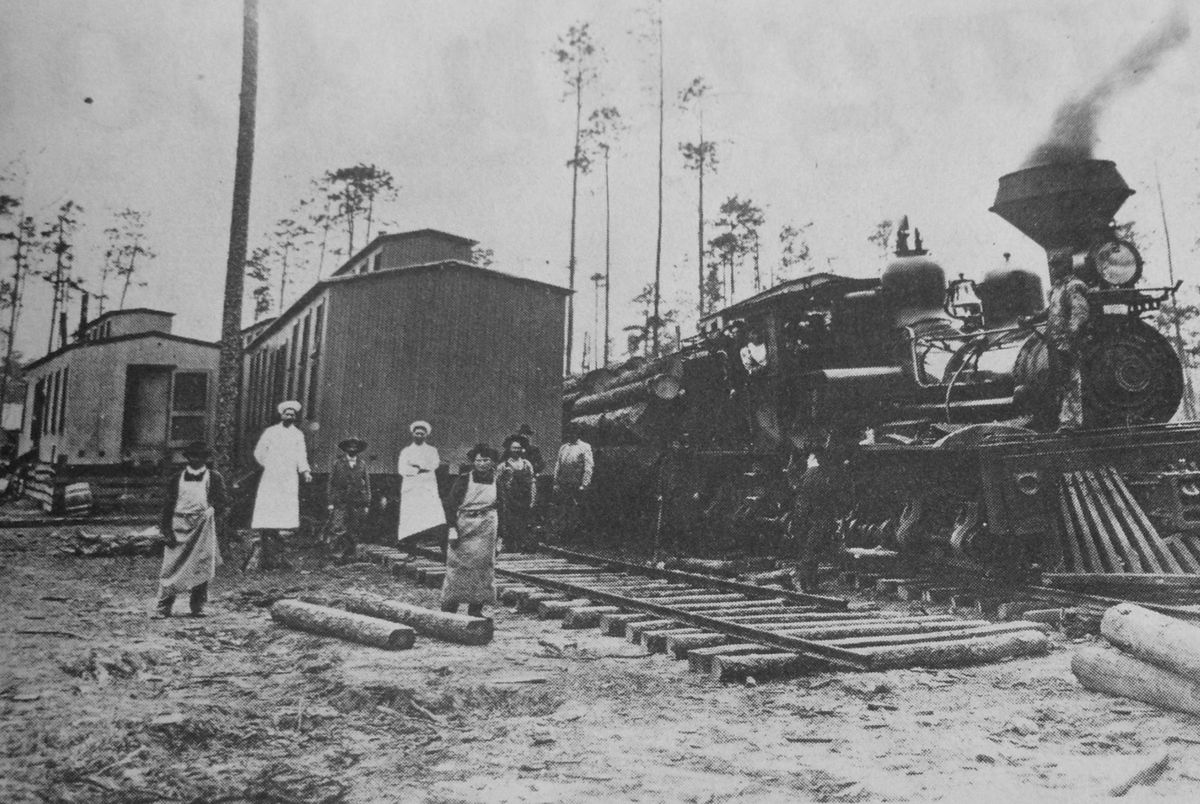 Covington County began its real growth in 1899 when the Central of Georgia Railroad extended its line to Andalusia from Searight, and the L & N Railroad ran a line from Georgiana through Andalusia and Opp to Graceville, Florida, and on to Florala at a later date. This progress brought new transportation which helped open the area to new frontiers in forest products, manufacturing, and trade. Prior to the “iron horse” arriving, Covington County’s economy was based solely on forest products and agriculture.
Covington County began its real growth in 1899 when the Central of Georgia Railroad extended its line to Andalusia from Searight, and the L & N Railroad ran a line from Georgiana through Andalusia and Opp to Graceville, Florida, and on to Florala at a later date. This progress brought new transportation which helped open the area to new frontiers in forest products, manufacturing, and trade. Prior to the “iron horse” arriving, Covington County’s economy was based solely on forest products and agriculture.
By 1900 the population of Andalusia was only 551, but many people lived on scattered farms at the time, adding to the population of the entire county. The city limits have expanded several times and consists of 18 square miles. The current population of the county seat stands at approximately 9,000, the largest town in the county.
Covington County as of 2024 had a population of 37,748. It has an area in square miles of 1,034 which is 9th in land size in the state. Covington County has 12 other incorporated towns: Opp, Florala, Red Level, River Falls, Carolina, Libertyville, Sanford, Heath, Gantt, Lockhart, Onycha, and Babbie.
